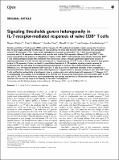Signaling thresholds govern heterogeneity in IL-7-receptor-mediated responses of naïve CD8⁺ T cells
Author(s)
Palmer, Megan Joan; Mahajan, Vinay S.; Chen, Jianzhu; Irvine, Darrell J; Lauffenburger, Douglas A
DownloadPalmer Immunol Cell Biol 2011.pdf (1007.Kb)
PUBLISHER_CC
Publisher with Creative Commons License
Creative Commons Attribution
Terms of use
Metadata
Show full item recordAbstract
Variable sensitivity to T-cell-receptor (TCR)- and IL-7-receptor (IL-7R)-mediated homeostatic signals among naïve T cells has thus far been largely attributed to differences in TCR specificity. We show here that even when withdrawn from self-peptide-induced TCR stimulation, CD8+ T cells exhibit heterogeneous responses to interleukin-7 (IL-7) that are mechanistically associated with IL-7R expression differences that correlate with relative CD5 expression. Whereas CD5[superscript hi] and CD5[superscript lo] T cells survive equivalently in the presence of saturating IL-7 levels in vitro, CD5[superscript hi] T cells proliferate more robustly. Conversely, CD5[superscript lo] T cells exhibit prolonged survival when withdrawn from homeostatic stimuli. Through quantitative experimental analysis of signaling downstream of IL-7R, we find that the enhanced IL-7 responsiveness of CD5[superscript hi] T cells is directly related to their greater surface IL-7R expression. Further, we identify a quantitative threshold in IL-7R-mediated signaling capacity required for proliferation that lies well above an analogous threshold requirement for survival. These distinct thresholds allow subtle differences in IL-7R expression between CD5lo and CD5hi T cells to give rise to significant variations in their respective IL-7-induced proliferation, without altering survival. Heterogeneous IL-7 responsiveness is observed similarly in vivo, with CD5[superscript h]i naïve T cells proliferating preferentially in lymphopenic mice or lymphoreplete mice administered with exogenous IL-7. However, IL-7 in lymphoreplete mice appears to be maintained at an effective level for preserving homeostasis, such that neither CD5hi IL-7R[superscript hi] nor CD5lo IL-7R[superscript lo] T cells proliferate or survive preferentially. Our findings indicate that IL-7R-mediated signaling not only maintains the size but also impacts the diversity of the naïve T-cell repertoire.
Date issued
2011-02Department
Massachusetts Institute of Technology. Department of Biological Engineering; Massachusetts Institute of Technology. Department of Biology; Massachusetts Institute of Technology. Department of Materials Science and Engineering; Koch Institute for Integrative Cancer Research at MITJournal
Immunology and Cell Biology
Publisher
Nature Publishing Group
Citation
Palmer, Megan J et al. “Signaling thresholds govern heterogeneity in IL-7-receptor-mediated responses of naïve CD8+ T cells.” Immunology and Cell Biology 89.5 (2011): 581-594. © 2012 Australasian Society for Immunology
Version: Final published version
ISSN
0818-9641
1440-1711